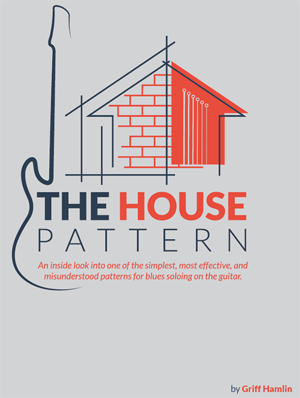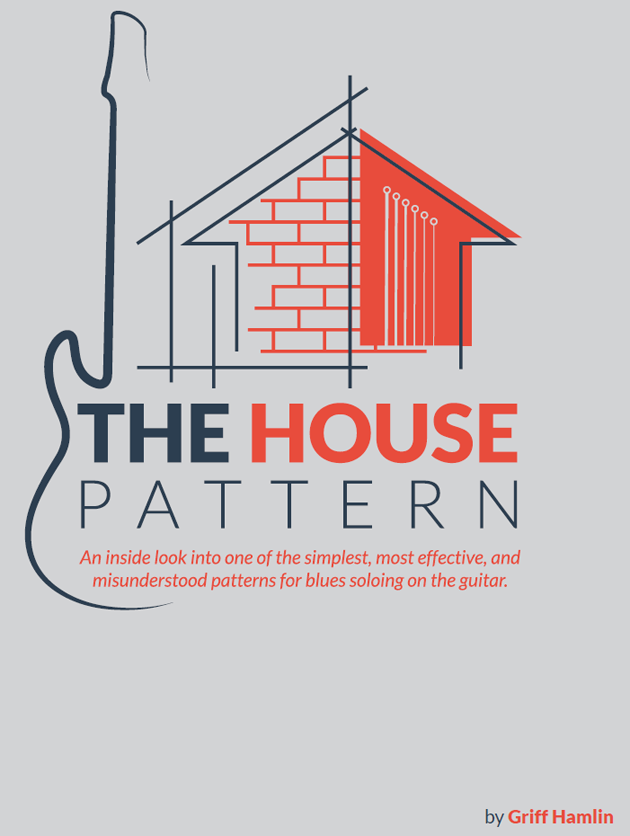“Finally, Master One Of The Simplest, Most Effective… And Misunderstood Patterns For Blues Soloing On The Guitar…”
Join Griff Hamlin as you deep-dive one of the most useful soloing patterns you may ever learn for blues guitar soloing… The House Pattern.
First things first… The House Pattern is often called “The BB King Box,” or “The BB King Pattern,” which is one of the main reasons I believe it is so misunderstood…
Calling it by that name entangles it with a style of blues soloing that has a certain sound and a certain style…
But that’s only the surface of what The House Pattern can do for you and your blues soloing.
Not only does it allow you to effortlessly slide back and forth between major and minor blues sounds so that you can easily navigate chord changes in a blues progression (or any other progression…)
But it “interfaces” with your regular pentatonic and blues boxes in such a way that you can, quite literally, get any sound you may want directly from this pattern.
And while you’ll find dozens, if not hundreds or videos online about “The BB King Box,” no one has really created a system of expanding on these amazing licks and ideas that can come from this seemingly tiny little pattern of notes…
Until now…
That System Is…

The House Pattern is one of the simplest, most effective, and misunderstood patterns for blues soloing on the guitar…
And in this course I’ll take you through understanding the pattern, and how you can use it to create both major and minor blues sounds quickly and easily without learning any new patterns along the way.
In addition, of course you’ll gain an understanding of how and when to use the variety of sounds you can reach…
Plus you’ll see how to add those cool sounding “blue” notes, and how to “interface” this amazing pattern with the other “boxes” that you probably are already using.
It consists of 11 sections (I know, a lot for one little pattern, right?)
- Section 1 – Here is where we’ll go over the nuts and bolts of the pattern, and how to use it to migrate between “major” and “minor” sounds (and why you’ll want to do that.)
- Section 2 – You’ll get 5 killer blues licks that use the house pattern, and for each of the licks you’ll have a major and a minor version of it…
- Section 3 – Here I’ve got 5 more great licks for you that are just a touch more challenging than the previous 5, but again there are major and minor versions of each.
- Section 4 – Bonus Solo 1 – The first of 5 bonus solos throughout the course, you’ll see one way in which all of the previous licks might be put together in a classic sounding blues solo.
- Section 5 – Here you’ll see that by simply changing your point of view of the house pattern, you can view it as a different scale entirely, and by sliding it down a couple of frets it interface with your traditional “box” patterns (box 2). This means 5 more licks as well.
- Section 6 – Here’s where you’ll see how to add in all the blue notes that really can make your blues soloing bluesy. However, knowing these notes are important for those times when you may not want them (if you’re doing more classic rock style soloing, for example)
- Section 7 – Bonus Solo 2 where again, we’ll use many of the previous licks in a 24 bar blues solo
- Section 8 – Here’s where you’ll see another “blending” technique using the house pattern and box 3 of the pentatonic scale. Again you’ll get 5 licks showcasing how this is done so you never have to just figure it out for yourself.
- Bonus Solo 3
- Bonus Solo 4
- Bonus Solo 5
And while all that might seem great, it’s just the information… not how it’s presented.
What really makes this system work is how each section is arranged and what you’ll do as you go through each lesson…
Here’s how (and why) The House Pattern works:
Most blues guitar players start out by learning things like the minor pentatonic or the minor blues scale in a series of 5 boxes…
And while those boxes work really well, and are great and you should absolutely use them…
If you look at your fretboard in a different way, it brings out new ideas, it’s a simple as that.
Plus, the boxes don’t lend themselves naturally to other sounds…
For example, if you’re playing along in A minor, and you decide to switch to A major pentatonic, can you do that without drastically changing your position on the guitar neck?
With the house pattern, switching between the major and minor blues sounds is, quite literally, built into the pattern.
Plus, it has different notes than the pentatonic scale, so that’s a bit of a different sound right there.
Now, all of this is great and will make your solos more interesting and give you a lot of easy-to-access options if you follow the system…
But what’s really important is the fact that you’re getting a tried-and-true method of actually incorporating these ideas into your own playing…
Because far too often I see students that may know it’s possible to play something, but don’t have that instant recall of ideas and licks that use that sound.
So with “The House Pattern,” you’ll go through certain steps that will make sure you can actually use these ideas…
1 – I’ll walk you through the memorization process, complete with how to count out the lick. Don’t worry if you can’t read music, you don’t have to, just do what I do and say what I say and you’ll not only have the notes memorized, you’ll have the “when” memorized (and that’s actually way more important!)
2 – Once you’ve got a handful of ideas under your belt, we’ll “trade” licks on-screen. I’ll play one of the ideas, and you play it back to me. This is a crucial step in bringing your inner ear into the soloing game, and every lesson that has licks incorporates this “trading” video into it.
3 – You’ll see several ways that the licks you’ve learned can be put together into solos. Most of the times it will be the whole lick, but sometimes it will only be part of a lick, or the end of one lick will get put together with the beginning of a different lick, or a section will be repeated. It’s remarkable how many possible ideas can be made from a handful of licks, and you’ll see that front and center as you play the solos.
So ultimately, not only will you learn a new soloing pattern that you can use over any blues tune, but you’ll improve your soloing as a whole from working through the trading and solo videos.
And There’s More To It Than Just Blues Soloing…
Of course blues is my first love, but these types of ideas come up in solos by The Beatles, Lynyrd Skynyrd, The Allman Brothers, Mountain, and tons of other classic rock and hard rock bands.
If you need a quick fill between vocal lines, you’d be hard-pressed to find a better “go to” pattern for that purpose.
Here are just some of the things you can do with the ideas and licks in “The House Pattern”…
- Easily and effortlessly mix between a major and minor blues sound, which you can also use over classic rock, country, and even jazz chord progressions.
- Be able to improvise with a single pattern that consists of just a handful of notes, and fill chorus after chorus without it sounding stale or boring because you can so easily change the tonality as you go.
- At a minimum, you’ll have about 40 new licks under your belt that don’t come from your usual sources and will always sound fresh and unique when you use them. Since most of these licks have a “major” and a “minor” version, they almost never sound the same twice.
- Instead of viewing the house pattern as something different, you’ll see how to incorporate it into the pentatonic boxes you already know. In fact, you’ll see that it’s almost a “drop in” replacement for “box 2,” (see section 5) and if you add “box 3” you can get some really cool licks (check out section 8 for those.)
- You’ll see “the blue notes” in an entirely different, but very useful way, after Section 6. The reality is that the blue notes are separate from the pentatonic or blues scale, but we really don’t teach or learn them that way. You’ll see that you can add them to anything easily.
- Have some killer “drop in” solos as you go through the bonus solos throughout the course – there are 5 in total!
And, depending on where you are now in your soloing journey, your improvising skills can really take a huge leap from taking advantage of the trading videos…
It’s so important to strengthen your ear/hand connection and trading does that better than anything I’ve ever seen or used in my nearly 35+ years as a guitar teacher.
They usually feel really awkward at first, but don’t give up on them, it’ll be worth it!
So Here’s What To Do Next
The House Pattern is just $57 and you can get it instantly as a digital download or stream it from your own private Member Portal on your computer or mobile device (as long as you have an internet connection.) It never goes away and you can access it any time…
The video player in the Member Portal allows you to loop sections of the video for practice, allows you to change the speed to slow things down or speed the up as you need, and you can save lessons to your own “favorites” list and come back to them instantly the next time you login.
All you have to do is click the “Add To Cart” button below, and complete the secure checkout to get your copy just a few minutes from now.
Is That It?
Pretty much.. that’s about it.
As always, you get my iron-clad, 90 day guarantee. If you don’t love The House Pattern, just let my friendly helpdesk know and you’ll get a complete refund, no questions asked – and you don’t even have to send it back.
My private students that have gone through some of this training have paid me upwards of $1000 or more for this information and done so willingly, and they don’t even get a money-back guarantee!
So to get this complete course, all 3 hours of video, complete TABs, audio playalongs, jam tracks, for $57 is kind of a no-brainer.
There’s no catch, no hidden continuity thing, and no shenanigans to be found. The order form is secure and you can rest assured that your privacy and data are safe. You’ve got absolutely nothing to lose.
Now Is The Time…
Putting this off until “someday” is just putting off success that much longer, and there’s no reason for that. If you really want to make improvements now, you have to act now, it’s that simple.
And with my 90 day no-questions-asked-you-don’t-even-have-to-send-it-back guarantee, this is the perfect chance to finally be soloing in the way you’ve always imagined you could.
So click the “Add To Cart” button below and within just a few minutes from now you can be starting to hear those sounds coming from your own guitar.
Oh yeah, one more thing…
All of the examples in the course are for a blues in A…
Now, of course, I show you how to change keys, it’s really easy to do, but we’ll talk you through it…
Since you might want to try other keys, I’ve provided complete jam tracks in every single natural key for you (A, B, C, D, E, F, G.)
There’s a full length and solo length (just 2 choruses, like the bonus solo examples) for each of those keys.
I guess you could call that a bonus, but really it’s just something I though you’d find useful as you start trying to use your new licks and I encourage you to take advantage of them as often as possible.
To get your complete copy of The House Pattern just click the yellow “Add To Cart” button below. Just as soon as your order is complete you will receive an email with your access instructions to the secure Member Portal so you can be creating exciting new blues solos in just a few minutes from now!

This is a one time payment, NOT a subscription. 3 Payment option is available on the next page.
PS – In case you thought, “Oh, I’ll just scroll down to the bottom and get the scoop,” let me hip you to it…
I’m offering you a great chance to try my new course called, “The House Pattern,” so you an add this amazing and often misunderstood pattern to your blues soloing bag-of-tricks…
There are 11 Sections of video lessons, licks, jam tracks, complete TABs, and so much more…
You can get it all for just $57, with my iron-clad 90 day guarantee. You love it or you get a refund, and you don’t even have to send it back.
Sound good? Great! Then get yours here.
